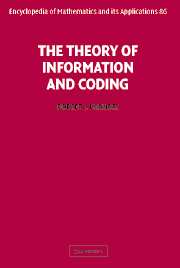Section editor's foreword
Published online by Cambridge University Press: 10 November 2009
Summary
Transmission of information is at the heart of what we call communication. As an area of concern it is so vast as to touch upon the preoccupations of philosophers and to give rise to a thriving technology.
We owe to the genius of Claude Shannon the recongnition that a large class of problems related to encoding, transmitting, and decoding informatio can be approached in a systematic and disciplined way: his classic paper of 1948 marks the birth of a new chapter of Mathematics.
In the past thirty years there has grown a staggering literature in this fledgling field, and some of its terminology even has become part of our daily language.
The present monograph (actually two monographs in one) is an excellent introduction to the two aspects of communication: coding and transmission.
The first (which is the subject of Part two) is an elegant illustration of the power and beauty of Algebra; the second belongs to Probability Theory which the chapter begun by Shannon enriched in novel and unexpected ways.
Information
- Type
- Chapter
- Information
- The Theory of Information and Coding , pp. ixPublisher: Cambridge University PressPrint publication year: 2002
